
Guide
The surround jungle: THX, DTS and Dolby
by Martin Jud
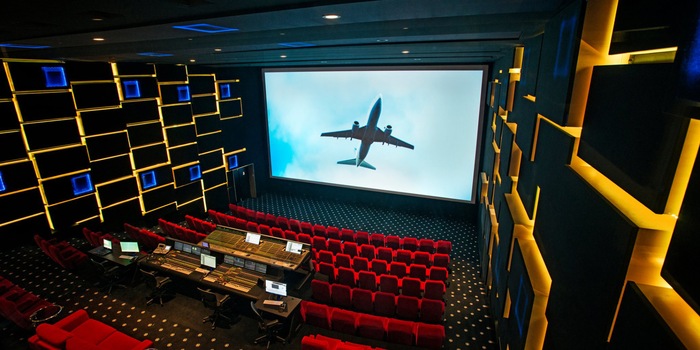
Do you know what Auro 3D has that Dolby Atmos and DTS:X don’t? A loudspeaker called «Voice Of God». Sounds pretty mighty and could explain why Hollywood has been paying attention to this relatively new surround technology since 2012.
Less attention was paid to Auro 3D in my article about THX, Dolby and DTS, in which I talk about the story of surround sound and how the different technologies work (in German).
Their chocolate is almost on par with Switzerland's stuff. Not to mention their cheese that is similarly legendary. But what the Belgians definitely do better is surround sound.
Back in 1980, at the tender age of 18, Wilfried Van Baelen set up his own sound studio together with his brother Guy. By the end of the eighties, it had evolved to a respected company. In 1995, the original name of the studio was changed from «Studio Galaxy» to «Galaxy Studios». The new headquarters finally allowed them to record entire orchestras in studio quality. Previously, this had only been possible with the help of external studios.
But this wasn’t enough for Wilfried. And so it happened in 2005 that he developed a concept for a new surround technology with 9.1 and 10.1 channels. This was then presented to the public in 2006 as Auro 3D.
To distribute Auro 3D, the Van Baelen brothers hooked up with Alfred Schefenacker back in 2010 and established the company «Auro Technologies». That same year, they presented the new Auro 3D formats with 11.1 and 13.1 channels. In 2011, Auro 3D finally made it to selected movie theatres. To cater for this type of venue and to offer a complete hardware package for home use, Auro Technologies entered into a partnership with screen manufacturer Barco. The Belgians pricked their ears, hoping that the surround sound would sound just as tasty as that cheese with the big holes from central Switzerland. And apparently it did! For in January 2012, «Red Tails» (Lucasfilm) was the first Hollywood flick to feature an Auro 3D audio mix.
Since then, channel-based Auro 3D has established itself in the movie industry. Deals with DreamWorks Animation and other studios followed. To break into the home-use market, Auro 3D collaborated with Datasat Digital Entertainment in 2013. Furthermore, there has been a partnership between Auro 3D, DTS and Barco since 2013. Together, they're working on an open standard for object-based 3D audio systems.
Unlike Dolby Atmos and DTS:X, Auro 3D is not object-based surround. In other words, channels are not calculated by the amplifier or playback device but are created in the classical way during the mastering of the movie.
What’s special about Auro 3D is that it’s based on Pulse Code Modulation (PCM), a technology developed by the Bell Labs and Alec Reeves in the 1930s. What they did was basically turn an analogue signal into a digital one (lossless). As 24-bit audio never fully utilises the 141 db dynamic range when played back, further information can be embedded into the PCM data stream. And that’s precisely what the «Auro 3D Octopus Codec» does. The codec merges multiple channels into one single PCM channel (12 to 6 with a 11.1 configuration). The result is practically lossless. As opposed to lossy codecs, this technology does reduce data that is often regarded as expendable because of psychoacoustics.
Auro 3D is available for both small (home) and large venues (cinemas). Configurations with 9.1 and 10.1 channels are for home use; configurations with 11.1 and 13.1 for cinemas. The Voice of God (read more about it below) is available from 10.1-channel configuration.
Working with a classic 5.1 setup basis (left front, centre, right front, left surround, right surround, subwoofer), a 9.1 configuration adds four extra height speakers (left front height, right front height, left surround height, right surround height).
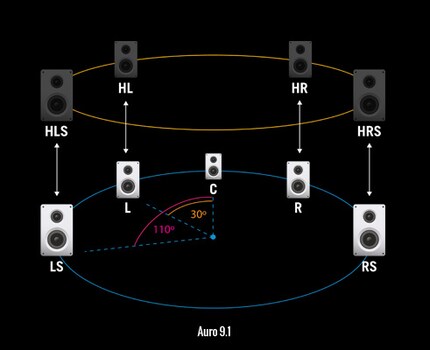
And now for the Voice of God (top ceiling speaker) – a speaker mounted directly above the head of the listener. For the first time ever, a 10.1 configuration now has three layers of sound: Ear layer (surround layer), height layer and top layer.
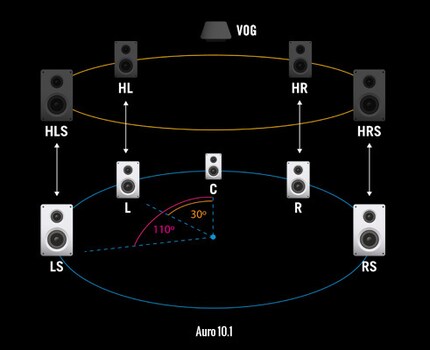
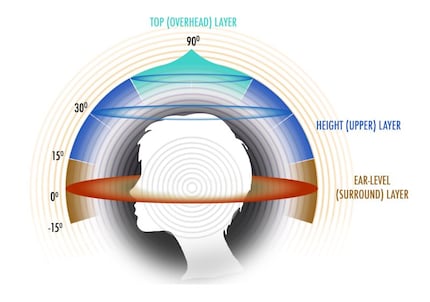
The 11.1 configuration in cinemas has the same setup as the 10.1 configuration. However, an extra height speaker located above the centre speaker is added.
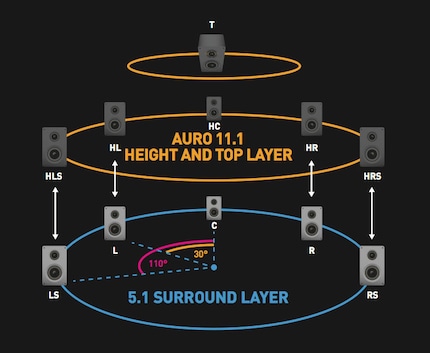
For a 13.1-channel system, two extra rear speakers (also known as rear surround speakers) are added to the surround layer. This configuration is based on a classic 7.1 system.
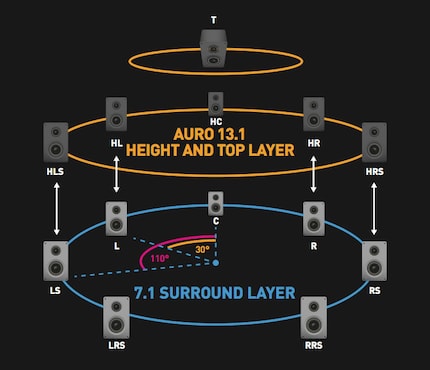
An Auro 3D configuration is compatible with Dolby Atmos and DTS:X. Mind you, because of the top ceiling speaker (Voice of God), Auro 3D surround (10.11, 11.1 and 13.1) playback is restricted on configurations by Dolby Atmos and DTS:X.
Along with the four Auro 3D technologies for movie theatres and home use, Auro technologies also offers 11.1-channel virtual surround for stereo headphones.
Auro 3D formats in a head-to-head comparison:
| Surround technologies by Auro Technologies | Area of use | Codec or applied technology | Number of channels | Channel setup | Channel or object-based |
|---|---|---|---|---|---|
| Auro 9.1 (2006) | Home cinema | Auro 3D Octopus Codec (PCM-based, practically lossless) | 9.1 | Left Front, Center, Right Front, Left Front Height, Right Front Height, Left Surround, Right Surround, Left Surround Height, Right Surround Height, LFE (Subwoofer) | Channel-based |
| Auro 10.1 (2006) | Home cinema | Auro 3D Octopus Codec (PCM-based, practically lossless) | 10.1 | Left Front, Center, Right Front, Left Front Height, Right Front Height, Left Surround, Right Surround, Left Surround Height, Right Surround Height, Voice of God, LFE (Subwoofer) | Channel-based |
| Auro 11.1 (2010) | Cinema | Auro 3D Octopus Codec (PCM-based, practically lossless) | 11.1 | Left Front, Center, Right Front, Left Front Height, Center Height, Right Front Height, Left Surround, Right Surround, Left Surround Height, Right Surround Height, Voice of God, LFE (Subwoofer) | Channel-based |
| Auro 13.1 (2010) | Cinema | Auro 3D Octopus Codec (PCM-based, practically lossless) | 13.1 | Left Front, Center, Right Front, Left Front Height, Center Height, Right Front Height, Left Surround, Right Surround, Left Rear, Right Rear, Left Surround Height, Right Surround Height, Voice of God, LFE (Subwoofer) | Channel-based |
| Auro 3D Over Headphones (2014) | Headphones (virtual surround) | Auro 3D Engine (Auro-Matic for Upmixing) | 11.1 | Stereo headphones (virtual surround) | Channel-based |
I’m curious to see how Auro 3D will expand in the future. Searching our shop for hardware that supports Auro 3D, I find that they are still somewhat underrepresented. However, I wouldn’t be surprised if this is about to change.
I also can’t wait to see if Auro 3D, DTS and Barco will manage to develop an open standard for object-based surround up to market readiness. I don’t believe Auro 3D will continue to focus in channel-oriented surround, not even in a more distant future. After all, the advantages of channel-independent audio objects are simply too many.
I find my muse in everything. When I don’t, I draw inspiration from daydreaming. After all, if you dream, you don’t sleep through life.
Practical solutions for everyday problems with technology, household hacks and much more.
Show all